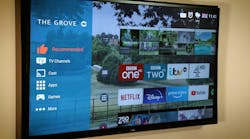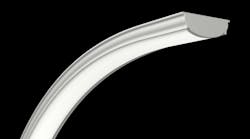Taking LEDs Back to Nature
Combining Seoul Semiconductor’s patented LED chip technology & Toshiba Materials’ TRI-R phosphor technology, SunLike Series LEDs deliver the world’s best light quality in a next-generation LED that enables human-centric lighting optimized for circadian rhythms
ANSAN, South Korea (June 26, 2017) – Seoul Semiconductor, a global innovator of LED products and technology, has developed a new LED technology that produces light that closely matches the spectrum of natural sunlight. Announced at a press conference in Frankfurt, Germany on June 26, 2017, the new SunLike Series natural spectrum LED technology was co-developed by Seoul Semiconductor and Toshiba Materials.
Back to natural light
Human beings have lived under natural sunlight for tens of thousands of years, and only began using lanterns in the third century BCE. The use of white LEDs for general illumination began less than 20 years ago, but has spread rapidly around the world due to the high efficiency and cost savings of LED lighting. However, low cost and brightness has been given priority over the quality of light, thus the light from conventional LEDs has a different characteristic from that of natural sunlight, which matches the human biorhythm.
The SunLike Series LED technology closely matches the spectrum of natural sunlight that human have enjoyed for thousands of years. It maximizes the advantage of natural light and minimizes the shortcomings of artificial light sources, providing light more like natural sunlight. This natural spectrum of light is achieved by combining Seoul Semiconductor’s world-class LED chip technology with Toshiba Materials’ TRI-R technology, a leading global phosphor compound.
“Mr. Kumpei Kobayashi, CEO of Toshiba Materials said that “We are pleased to be partnered with a global LED leader like Seoul Semiconductor to introduce the SunLike Series natural spectrum LEDs, which represent an advanced technology that creates a more intimate and nature-based lighting environment.”
“We are pleased to introduce another South Korean innovation in LED technology with the launch of the SunLike Series LED lighting technology that produces light close to the spectrum of natural sunlight. Much like our package-less WICOP Series LEDs revolutionized the LED packaging process, our SunLike Series LEDs represents a revolution in creating natural spectrum LED lighting.” said Mr. Chung Hoon Lee, CEO of Seoul Semiconductor. “The SunLike Series LEDs will be applied in the lighting sector, contributing to a better and healthier life for humans. They will also be used in horticultural applications to create an ideal environment to help plants grow, which is safer than using genetic modification,” he added.
He also said “We are delighted to partner with Toshiba Materials to provide our customers a light source that delivers the natural spectrum of sunlight – from the brightness of morning sunshine, to the energy of daylight, to the warmth of an evening sunset. We believe that the SunLike Series LEDs will improve the quality of human life by advancing a new era of human-centric lighting technology.”
Minimizing the side-effects of blue light
Because SunLike Series LEDs are designed to deliver light that closely matches the natural spectrum of sunlight, they provide an optimized light source for human centric lighting that maximizes benefits of natural light while minimizing the negative side effects of artificial light sources.
Some recent studies1 from Harvard and other major universities have suggested that blue LED chips, used in most commercial LEDs to create visible light, provide positive stimulation to the human eye that increases alertness and elevates mood when viewed during daytime hours. However, these blue LEDs create a blue light “spike” in the light output of an LED that may produce negative effects when viewed for prolonged periods during night-time hours by interfering with natural human biorhythms. The SunLike Series natural spectrum LED technology employs a purple LED in conjunction with the TRI-R phosphor compound to minimize the blue light “spike” that is characteristic of typical LED light sources, producing a light output that closely matches the spectrum of natural sunlight to deliver a healthier light experience.
SunLike’s world-class color reproduction
According to the results of published research in academic journals such as Nature2, because humans have lived under the sun for thousands of years, human organs and biorhythms have evolved to respond most appropriately to natural sunlight. Human retinal cells that interpret and respond to color-related light input are composed of red, blue, and green cones, and the percentage of blue receptors was only 5.7%.
Caption for attached image:
Because the amount of blue light that our eyes can accept is limited, blue light above the limit entering the eye is scattered. When this scattering phenomenon occurs, the light is diffused, and as a result, the texture and color of objects are distorted. Also, excess blue light can over-stimulate these retinal cells in the eye, and may cause eyestrain and loss of concentration. However, since SunLike Series LEDs implement the spectrum closest to the sunlight, they more accurately represent the color and texture of the object in natural light without the negative effects of excessive blue light on the eye or human biorhythms. Several products in which Toshiba’s TRI-R technology were incorporated have already been applied to lighting in Milan Fashion Week and illuminating fine art paintings in museum settings.
Applications and Market Forecast
SunLike will primarily be applied in commercial facilities that need to distinguish or show the exact color of the product as seen under sunlight, such as department stores, fine jewelers, horticulture facilities for growing plants indoors, exhibition facilities such as museums and exhibition halls, cosmetic facilities such as dressing rooms or bathrooms.
The global lighting market is estimated at $87 billion, with LED lighting accounting for ~$35 billion. The overall segment of the LED market where the SunLike Series LEDs can be applied represents ~$17 billion. It is anticipated that the SunLike Series natural spectrum LEDs will find initial sales in applications that require high quality lighting, and will eventually be applied in the general lighting market.
The SunLike Series natural spectrum LEDs are available from Seoul Semiconductor. To learn more about the SunLike Series natural spectrum LEDs, please visit: http://www.seoulsemicon.com/en/technology/Sunlike/
For more information about Seoul Semiconductor, please visit http://www.seoulsemicon.com
1 Blue Light Article (Source: Harvard Medical School)
http://www.health.harvard.edu/staying-healthy/blue-light-has-a-dark-side
2Source: http://www.nature.com/nature/journal/v397/n6719/full/397520a0.html
Nature paper number: Roorda et al. Nature, 397, 520-522, (1999)
About Seoul Semiconductor:
Seoul Semiconductor develops and commercializes light emitting diodes (LEDs) for automotive, general illumination, specialty lighting, and backlighting markets. As the fourth-largest LED manufacturer globally, Seoul Semiconductor holds more than 12,000 patents, offers a wide range of technologies, and mass produces innovative LED products such as WICOP – a simpler structured package-free LED which provides market leading color uniformity, cost savings at the fixture level with high lumen density and allows design flexibility; Acrich, the world's first high-voltage AC-driven LED technology developed in 2005, includes all AC LED-related technologies from chip to module and circuit fabrication, as well as multi-junction technology (MJT); and nPola, a new LED product based on GaN-substrate technology that achieves over ten times the output of conventional LEDs. For more information about Seoul Semiconductor, please visit http://www.seoulsemicon.com
About Toshiba Materials
Toshiba Materials Co., Ltd. (http://www.toshiba-tmat.co.jp/eng/) was de-merged from Toshiba Corporation in 2003. With material designing technology as a core, Toshiba Materials has supplied key material and key components which support the development of society.
Main products are metallic materials, components, fine ceramics parts, and chemical materials. During the year ended March 31, 2017, the company’s net sales totaled ~$127MM (14 billion yen).
# Trademarks
WICOP and Acrich are trademarks of Seoul Semiconductor Co., Ltd.
TRI-R is trademark of Toshiba Materials Co.





